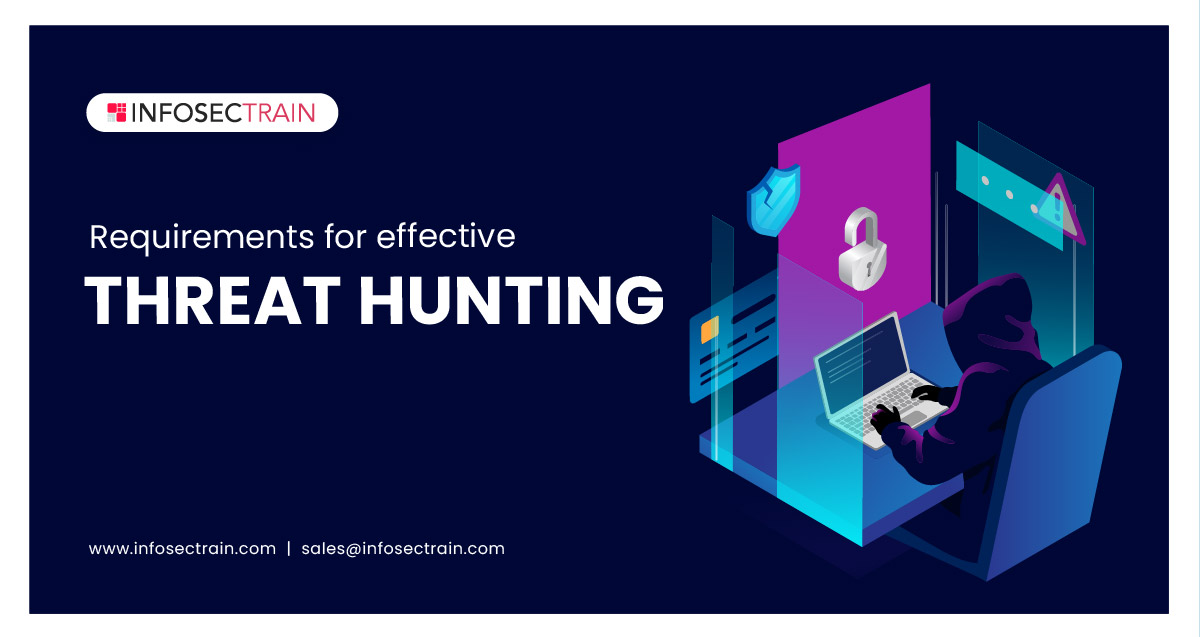Requirements For Effective Threat Hunting
Threat Hunting is a proactive technique used by security analysts to identify the undetected, unfamiliar, or non-remediated threats in the organization’s network. It includes iterative methods to identify Indicators of Compromise (IoCs) threats, such as Advanced Persistent Threats (APTs) and Hacker Tactics, Techniques, and Procedures (TTPs) that can exploit the existing system.

Types of Threat Hunting
Threat Hunting involves a deep investigation to identify potential threats in the organization’s network. The following are the three different types of Threat Hunting:
- Structured Hunting : A structured hunt is a process of identifying the threats based on the Indicator of Attack (IoA) and an attacker’s Tactics, Techniques, and Procedures (TTPs). The Threat Hunter can identify the attacker even before the attacker exploits the organization’s environment. The structured hunting uses the MITRE Adversary Tactics Techniques and Common Knowledge (ATT&CK) Framework using enterprise and PRE-ATT&CK frameworks.
- Unstructured Hunting : An unstructured hunt is a process of identifying threats based on a trigger with one or more Indicators of Compromise (IoCs). It often indicates the threat hunter to monitor the pre and post-detection patterns. The Threat Hunter can analyze the data retention and formerly associated offenses to determine the threat-hunting strategy.
- Situational Hunting : A situational hypothesis is an enterprise’s internal risk assessment or vulnerability analysis of the IT environment. Entity-oriented leads are derived from attack data collected from the public, revealing the latest TTP of existing cyber threats when examined.
How does Threat Hunting Work?
Threat hunters develop a baseline of authorized events to identify vulnerabilities for effective threat hunting. With the help of baseline, threat detection, and threat intelligence technologies, threat hunters will monitor the security of the data and information collected. These technologies include Endpoint Detection and Response (EDR), Security Information and Event Management solutions (SIEM), or other security analytics tools.
Once the techniques are implemented with data from varied sources such as endpoint, network, and cloud data, threat hunters will begin to search for suspicious activities, potential risks, or triggers. If a threat is identified, at first, the threat intelligence specifies new potential threats, and threat hunters can develop hypotheses to have in-depth network investigations. While investigating, the threat hunters identify and determine whether a threat is malicious or benign and monitor the network to prevent cyber threats.
Steps for Effective Threat Hunting
The process of effective Threat Hunting involves the following three steps that are required to follow:
1.Prepare for Hunt
The three components are essential before beginning the threat hunting process. They are as follows:
- Threat Hunter: A Threat Hunter is a threat-hunting professional responsible for identifying potential threats and vulnerabilities in the organization’s network. They are also responsible for developing, testing, and evaluating the hypotheses to identify threats.
- Data: To determine the hypotheses, the threat hunter requires access to the data. It helps to derive the processes and solutions from investigating the hypothesis.
- Tools: Threat Hunter should have access to the tools and technologies such as security monitoring tools, threat intelligence sources, analytics tools, and SIEM tools.
2. Develop a hypothesis
Developing the threat hypothesis is the first step in effective Threat Hunting. A hypothesis of a newly identified threat can be a trigger for effective threat hunting. This hypothesis is based on risks or vulnerabilities in the organization’s network, such as a trigger, suspicious activity, threat intelligence, or attacker TTPs that vary from the baseline activity.
The threat hunter is responsible for monitoring and leveraging their knowledge, experience, and problem-solving skills to develop a threat hypothesis.
3. Investigation
In the investigation, a threat hunter depends on complex and historical datasets emanating from threat hunting technologies such as EDR, SIEM, and User Entity Behavior Analytics (UEBA). The investigation will continue until the hypothesis is confirmed as malicious activities or deemed to be benign.
4. Resolution
Deploying an efficient response is the next step when malicious activity is found in the organization’s network. It includes implementing security patches, disabling users, updating authorization privileges, blocking IP addresses, introducing new identification requirements, and altering network configurations. In this phase, the security teams work to resolve network threats proactively by analyzing the Tactics, Techniques, and Procedures (TTPs) of attackers and determining how to mitigate threats from recurrence.
5. Prevent threats and enhance security
Effective threat hunting reveals the security gap in the organization’s network. This security gap has been overlooked and remained undetected during security assessment, and thus it created an attack surface allowing attackers to exploit.
It is required to patch the security gaps to prevent the recurrence of the same threat. Enhancing the existing security procedures and processes helps protect against different threats.
As cyber attackers are evolving with the latest threats, the job of threat hunting is becoming a prominent role in the organization. Cyber threat hunting should become a regular practice in the organization, operating by automated threat detection technologies and remediation processes.
Threat Hunting Professional with InfosecTrain
InfosecTrain is the best online training and consultancy service for a wide range of cybersecurity and information security domains. It offers an instructor-led online training program on Threat Hunting that helps achieve an in-depth understanding of its techniques, tools, and processes. Check out and enroll now to get certified as a Threat Hunting Professional.




 1800-843-7890 (India)
1800-843-7890 (India) 
